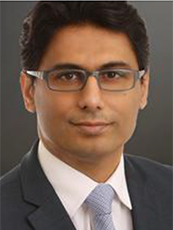Speakers

Mr. Murtuza SIKANDER
United Kingdom
Mr Sikander currently practices as a Consultant Neurosurgeon and Spinal Surgeon at the John Radcliffe Hospital in Oxford where he is the Lead Clinician for the Neurosurgical Spinal service.
Mr Sikander holds fellowship training programmes in skull base and spinal surgery from King’s College Hospital, The Royal Free Hospital, The Royal London Hospital and The John Radcliffe Hospital in Oxford. Prior to taking up a busy Neurosurgical practice in Oxford, he practised as a Consultant Neurosurgeon and spinal surgeon at St Mary’s Hospital and Charing Cross Hospital in London.
Mr Sikander treats patients with a wide variety of spinal disorders including spinal pain due to degenerative pathology, spinal stenosis, spinal cord tumours, spinal vascular malformations, adult congenital malformations, Arnold-Chiari Malformations, spinal cord syrinx and patients requiring complex revision surgeries.
He also treats cranial disorders and has a sub-specialist interest in Normal Pressure Hydrocephalus, which is a very common and debilitating but treatable condition that may masquerade as dementia in the elderly.
Objective: Spine awake surgery (SAS) aims to achieve faster recovery times, better outcomes, and a lesser economic impact on society. Our drive to establish SAS was to improve patient outcomes and health economics during the COVID-19 pandemic. After a systematic review and to the best of our knowledge, SAS, the Oxford Protocol, is the first protocolized pathway that aims to train bespoke teams performing SAS safely, efficiently, and in a standardized repeatable fashion. A pilot study was designed around newly derived protocols and simulated training to determine if SAS is a safe and implementable pathway to improve patient outcomes and health economics.
Methods: We assessed a cohort of 10 patients undergoing one-level lumbar discectomies and decompressions, analyzing the related costs, length of stay, complications, pain management, and patient satisfaction.
Results: The age range of our patients was 46-84 years. Three discectomies and 7 central canal stenosis decompressions were performed. Eight patients were discharged on the same day. All patients gave positive feedback about their experience of SAS. A significant cost saving was made compared to a general anesthesia (GA) overnight stay across the group. No on day cancellations occurred due to lack of bed availability. No patient needed analgesia in the recovery room or needed additional analgesia over and above the SAS e-prescription take home package.
Conclusions: Our early experience and journey reinforce our drive to push forward and expand on this process. It aligns with the international literature which highlights this approach as safe, efficient, and economical.
Keywords: Health economics; Patient benefits; Patient journey; Spine awake surgery.